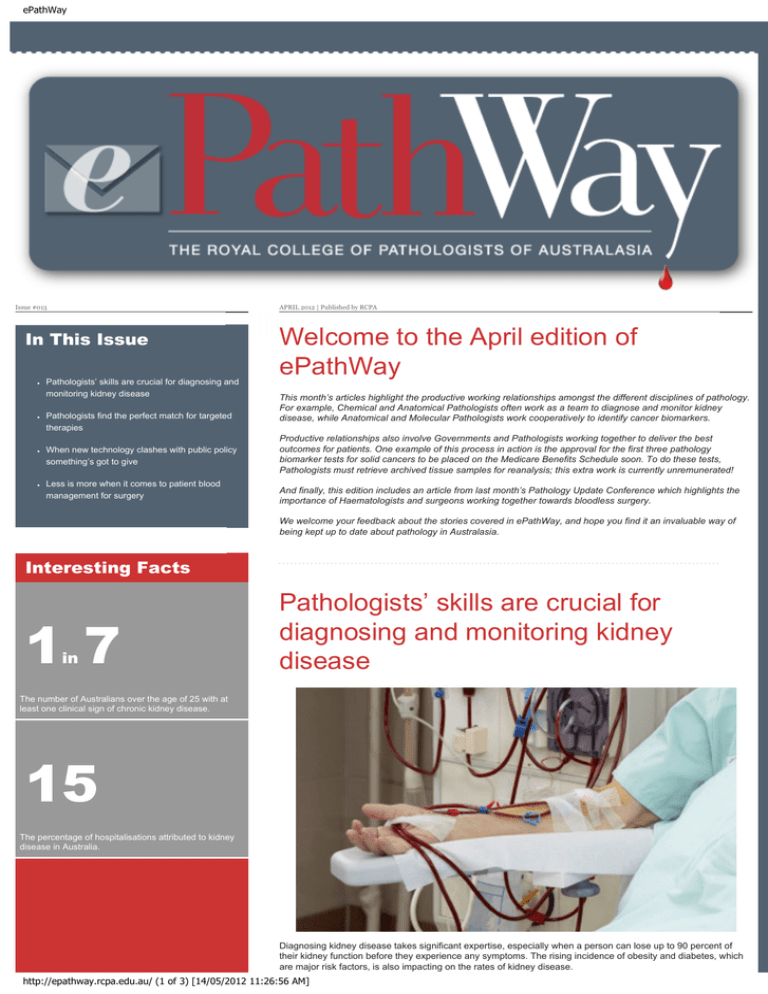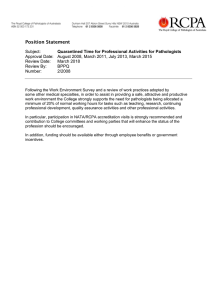Welcome to the April edition of ePathWay In This Issue
advertisement

ePathWay Issue #013 APRIL 2012 | Published by RCPA In This Issue ● Pathologists’ skills are crucial for diagnosing and monitoring kidney disease ● Pathologists find the perfect match for targeted therapies ● When new technology clashes with public policy something’s got to give ● Less is more when it comes to patient blood management for surgery Welcome to the April edition of ePathWay This month’s articles highlight the productive working relationships amongst the different disciplines of pathology. For example, Chemical and Anatomical Pathologists often work as a team to diagnose and monitor kidney disease, while Anatomical and Molecular Pathologists work cooperatively to identify cancer biomarkers. Productive relationships also involve Governments and Pathologists working together to deliver the best outcomes for patients. One example of this process in action is the approval for the first three pathology biomarker tests for solid cancers to be placed on the Medicare Benefits Schedule soon. To do these tests, Pathologists must retrieve archived tissue samples for reanalysis; this extra work is currently unremunerated! And finally, this edition includes an article from last month’s Pathology Update Conference which highlights the importance of Haematologists and surgeons working together towards bloodless surgery. We welcome your feedback about the stories covered in ePathWay, and hope you find it an invaluable way of being kept up to date about pathology in Australasia. Interesting Facts 17 in Pathologists’ skills are crucial for diagnosing and monitoring kidney disease The number of Australians over the age of 25 with at least one clinical sign of chronic kidney disease. 15 The percentage of hospitalisations attributed to kidney disease in Australia. Diagnosing kidney disease takes significant expertise, especially when a person can lose up to 90 percent of their kidney function before they experience any symptoms. The rising incidence of obesity and diabetes, which are major risk factors, is also impacting on the rates of kidney disease. http://epathway.rcpa.edu.au/ (1 of 3) [14/05/2012 11:26:56 AM] ePathWay read more » 79,072 $ The cost per person per year for dialysis in a hospital or haemodialysis unit. Pathologists find the perfect match for targeted therapies Source: Kidney Health Australia website Important Message Targeted therapy is revolutionising cancer management, and the good news is the first three pathology biomarkers tests for solid cancers – HER2, KRAS and EGFR1 - have been approved to be placed on the Medicare Benefits Schedule (MBS). According to Associate Professor Adrienne Morey, Director of Anatomical Pathology at St Vincent’s Hospital in Sydney, this represents a huge paradigm shift by the government, and there are more tests in the pipeline. has an important message for you. Click to see the message! read more » Suggest to a friend Know someone who might be interested in this website? Why not suggest the website to them. When new technology clashes with public policy something’s got to give Previous Editions The winds of change are blowing through diagnostic and treatment practices of the past thanks to the genetic revolution. Vast collections of tissue samples, which were once used to diagnose cancer and other diseases before being permanently archived, are being requested again by medical practitioners and reanalysed by pathologists as molecular testing and targeted therapy becomes a reality. This is great news for patients who are benefiting from this new technology, but not for the pathology laboratories. They are required to do this work for free which is putting a strain on their already lean operations. Did you miss something from last month? You can view our previous editions at any time. Subscribe Now! Subscription is easy! Simply fill in our subscription form. Links read more » RCPA Manual LabTest Online Less is more when it comes to patient blood management for surgery What on earth is patient blood management for surgery? Well, it’s having surgery using blood products only when absolutely necessary, and there is growing evidence that this approach improves patient outcomes. Aiming to avoid using blood products in http://epathway.rcpa.edu.au/ (2 of 3) [14/05/2012 11:26:56 AM] ePathWay surgery is a key component of Patient Blood Management programs which advocate a ‘less is more approach’ when it comes to having a blood transfusion. read more » Copyright © 2012 The Royal College of Pathologists of Australasia RCPA - Durham Hall - 207 Albion St Surry Hills NSW 2010 AUSTRALIA | (+61) 2 8356 5858 | www.rcpa.edu.au Privacy Policy | Legal | Disclaimer Unsubscribe http://epathway.rcpa.edu.au/ (3 of 3) [14/05/2012 11:26:56 AM] ePathWay - Article One APRIL 2012 | Published by RCPA Issue #013 Pathologists’ skills are crucial for diagnosing and monitoring kidney disease Dr Graham Jones, Chemical Pathologist at SydPath. Photo: Elizabeth Adams Diagnosing kidney disease takes significant expertise, especially when a person can lose up to 90 percent of their kidney function before they experience any symptoms. The rising incidence of obesity and diabetes, which are major risk factors, is also impacting on the rates of kidney disease. “The impact of kidney disease is increasing,” says Associate Professor Paul McKenzie, Anatomical Pathologist at the Royal Prince Alfred Hospital in Sydney. “It is a serious problem and kidney failure can lead to dialysis or the need for a kidney transplant.” The kidneys are about the size of an adult fist and are tucked under the rib cage for protection. They sort the body’s recyclable waste from the non-recyclable, 24 hours a day, seven days a week, and ensure the right amount of waste and fluids are removed from the body. The kidneys also process about 200 litres of blood – drop by drop through tiny tubules - as it circulates through the kidneys about 12 times a day, keeping it clean and chemically balanced. They also make hormones involved in blood pressure control, the production of red blood cells and the uptake of calcium into the bones. When they start to falter it’s obviously bad news for the body. According to Dr Graham Jones, Chemical Pathologist at SydPath in Sydney, kidney disease requires at least two pathology disciplines to diagnose and monitor its progress. Chemical Pathologists can identify the first warning signs something is wrong with a simple blood test called the eGFR (estimated glomerular filtration rate) which picks up decreased kidney function. Dr Jones was part of the working party which recommended the eGFR is measured every time an adult has a serum creatinine level (a marker of kidney disease) requested in Australia. “This simple initiative facilitated a change across the whole country and put kidney disease in the line of sight of GPs when they read the pathology reports,” explains Dr Jones. “This ongoing work is a collaborative effort with Kidney Health Australia1 and other medical groups.” At the other end of the spectrum, Anatomical Pathologists such as A/Professor McKenzie step in when kidney disease is more advanced and a http://epathway.rcpa.edu.au/one.html (1 of 2) [14/05/2012 11:27:01 AM] ePathWay - Article One more detailed diagnosis is needed. They can do this by examining kidney biopsy tissue samples using light and fluorescent microscopy as well as a powerful electron microscope to examine fine detail. “Diagnosing kidney disease is very labour intensive and is a specialised field of pathology. It requires extra training and a partnership with an electron-microscopy unit,” says A/Professor McKenzie. “There are also other specialised techniques used to diagnose kidney disease such as immunofluorescence which use antibodies attached to fluorescent dye to detect immune complexes in the kidney tissue. The pattern of deposition can help to characterise the particular type of kidney disease.” A/Professor McKenzie says the electron microscope magnifies to a much higher level than the light microscope and enables the pathologist to examine the fine structure of kidney tissue, which is not possible by any other means. Defining the nature of the type of kidney disease by pathology determines the type of treatments that may be available and the long-term outlook. Diagnosing kidney disease early is vital for its management and treatment. Advanced kidney disease can lead to dialysis, which is very intrusive and a burden on the patient involved and on the health system. In its end stages, kidney disease results in transplantation or death. Pathologists’ skills are crucial for diagnosing and monitoring kidney disease, which often starts with a simple blood test to measure the eGFR, and might end with a tissue sample under an electron microscope. Art and jewellery auction helps fund a new electron microscope Electron microscopes come with a price tag of about $600,000, so not every hospital has one. Concord Hospital, which is the referral centre for electron microscopy for a number of hospitals in NSW, has two machines that are over 20 years old and need to be replaced. Budgets are tight, so the pathology staff thought outside the box and applied to be the recipient of fund raising events at Concord Hospital last financial year. “Funds have been promised from trust and research funds, but we had to do our bit as well,” explains Associate Professor Betty Lin, Director of Anatomical Pathology at Concord Hospital. “One of the events we held was an art and jewellery auction where pathology staff from a number of hospitals were among those who contributed items they had made and painted to help raise funds for the new microscope.” They hope to take delivery of their new machine some time this year which will be good news for patients with kidney disease. 1Kidney Health Australia http://www.kidney.org.au « Back to Home Page Copyright © 2012 The Royal College of Pathologists of Australasia RCPA - Durham Hall - 207 Albion St Surry Hills NSW 2010 AUSTRALIA | (+61) 2 8356 5858 | www.rcpa.edu.au Privacy Policy | Legal | Disclaimer Unsubscribe http://epathway.rcpa.edu.au/one.html (2 of 2) [14/05/2012 11:27:01 AM] ePathWay - Article Two APRIL 2012 | Published by RCPA Issue #013 Pathologists find the perfect match for targeted therapies Targeted therapy is revolutionising cancer management, and the good news is the first three pathology biomarkers tests for solid cancers – HER2, KRAS and EGFR1 - have been approved to be placed on the Medicare Benefits Schedule (MBS). According to Associate Professor Adrienne Morey, Director of Anatomical Pathology at St Vincent’s Hospital in Sydney, this represents a huge paradigm shift by the government, and there are more tests in the pipeline. “In the past there has been a disconnect between the approval of drugs by the Pharmaceutical Benefits Schedule (PBS) with their companion biomarker tests,” she explains. “Now they are bringing the two together and drugs are not approved unless there is the right test for that drug.” Cancer biomarkers are present in the tumour tissues, or in the blood, and they can be used to predict if patients might respond to a particular drug. This is the essence of targeted therapy. A/Professor Morey says Pathologists are the gatekeepers to these therapies, as they select the “right” people who have the best chance of treatment, and also make sure the “wrong” people who won’t respond to this therapy are not put through unhelpful treatment. “For example, the HER2 receptor for breast cancer is only overexpressed in about 15 percent of women with invasive breast cancer. This is usually a consequence of having extra copies of the HER2 gene in the tumour cells. We have to identify this subgroup of patients who have the potential to respond to therapy targeted against the HER2 protein,” she explains. “Unfortunately, even if a potential weakness in the tumour is identified that might respond to a specific targeted therapy, there is increasing concern that tumours might “mutate” and become resistant to that therapy, so it may become necessary to hit multiple targets at once.” Professor Stephen Fox, Director of Pathology at the Peter MacCallum Cancer Centre in Melbourne, describes targeted therapy as part revolution and part evolution of the role of Anatomical Pathologists. “Anatomical Pathologists are pivotal in this new paradigm. They ensure the testing to identify the critical mutations performed by the Molecular Pathologists/Scientists is done on tumour tissue.” Selecting the most relevant tissue sample is critical in targeted therapy to ensure the amount and proportion of tumour cells that are tested are adequate. The appropriate sample is then given to a Molecular Pathologist to test for the relevant companion biomarkers for a particular drug. While this process sounds straight forward, there are still issues to iron out. Professor Fox says the HER2 test has been used in Australia since http://epathway.rcpa.edu.au/two.html (1 of 2) [14/05/2012 11:27:03 AM] ePathWay - Article Two 2006, but has only just made it on to the MBS this year. “Basically we need to fund more molecular pathology tests. Patients may need a battery of molecular tests where we measure several biomarkers, but only one or two might be reimbursed.” Professor Fox says other issues include the short fall of Molecular Pathologists to cope with this new work, and ensuring there is a close relationship between anatomical and molecular pathology. Without these the quality of the results can be compromised. A/Professor Morey agrees. “There are not many Molecular Pathologists around who deal with companion biomarkers, and there are not many in training either,” she says. “This often means we have to send tissue away to other labs for testing which affects the turn-around-times for delivering the results to oncologists. It is also an impost on the initial lab as they often need to retrieve the original tissue out of the archives for these tests.2” Targeted therapy is going play a large role in the future of cancer management, and while there are still issues to sort out, having three pathology biomarkers tests for solid cancers placed on the MBS is a small but encouraging start. 1 2 HER2 - Human Epidermal Growth Factor Receptor 2, KRAS – Kirsten Rat Sarcoma, EGFR - Epidermal Growth Factor Receptor. Tissue Banking is covered in this issue of ePathWay. « Back to Home Page Copyright © 2012 The Royal College of Pathologists of Australasia RCPA - Durham Hall - 207 Albion St Surry Hills NSW 2010 AUSTRALIA | (+61) 2 8356 5858 | www.rcpa.edu.au Privacy Policy | Legal | Disclaimer Unsubscribe http://epathway.rcpa.edu.au/two.html (2 of 2) [14/05/2012 11:27:03 AM] ePathWay - Article Three APRIL 2012 | Published by RCPA Issue #013 When new technology clashes with public policy something’s got to give The winds of change are blowing through diagnostic and treatment practices of the past thanks to the genetic revolution. Vast collections of tissue samples, which were once used to diagnose cancer and other diseases before being permanently archived, are being requested again by medical practitioners and reanalysed by pathologists as molecular testing and targeted therapy becomes a reality. This is great news for patients who are benefiting from this new technology, but not for the pathology laboratories. They are required to do this work for free which is putting a strain on their already lean operations. “Pathologists are the custodians of tissue samples and they have legal ownership of them,” explains Dr Nik Zeps, Research Group Leader at St John of God Health Care in Perth. “So, when a request comes in to reanalyse a sample, they need to retrieve it from the archive, which may be an in-house facility or off site in a commercial storage facility, and process it again. This might also involve sending it to another testing facility because molecular pathologists are few and far between.” Dr Zeps says his lab retrieves several hundred tissue samples a year with no cost recovery; and that’s just at the start of this technology. He believes the number of samples to be retrieved will only increase over time as this new technology takes hold. Dr Tony Landgren, Anatomical Pathologist at the Royal Melbourne Hospital and Healthscope Pathology, echoes Dr Zeps’ concerns. He says his laboratory is receiving requests to retrieve hundreds of these tissue samples each year and process them again at a conservative estimate of $100-$200 for each sample - with no cost recovery. This amount does not include the cost of performing the new tests, which may or may not be covered by Medicare. “There is no Medicare benefit for retrieval/reprocessing and no dollars within the few genetic tests that have a Medicare benefit to pay for this component,” he says. “There is also no other public funding. Occasionally we can get help if a diagnostic test is coupled to research.” Dr Landgren calls this situation a collision of public policy and a stretched health budget, but the effect of not finding a way to remunerate this extra work will be detrimental to patients. “Patients will not have access to this new health revolution if they can’t afford to pay for it themselves because private pathology laboratories need to survive commercially. They will not be able to keep doing this work for free,” he says. “If it’s in the public sector then pathologists will try to do it within the existing budget but that’s not going to be easy either. In the end the patients will bear the cost.” http://epathway.rcpa.edu.au/three.html (1 of 2) [14/05/2012 11:27:04 AM] ePathWay - Article Three Dr Landgren says this situation is already becoming a burden on his laboratory and they are currently ‘batching’ these requests and only processing 20 at a time. That’s the tough reality on patients and their families who may have a second chance at living healthy lives thanks to the emerging genetic therapies. “If a new pathology test comes onto the pathology schedule, then we must show that it is cost effective,” says Dr Landgren. “However, this will be difficult to show with this new technology because the costs of retrieving tissue samples and reclassifying them for targeted therapy will probably be offset outside of the pathology sector such as through savings in surgery costs, health prevention, shorter hospital stays and people living longer healthier lives and contributing to society for longer.” And the elephant in the room is … Dr Zeps says another unspoken but looming issue will be the difficulty of biobanking in the future. Biobanks are special facilities which store human biological samples for use in research. They rely on access to excess tissue specimens, but as archived tissues become “active” specimens again, spare tissue will probably become a concept of the past. Dr Zeps says one solution may be integrating “consent to research” as a routine part of any patient having samples sent to a pathology practice. His laboratory has been doing this as part of their colorectal practice for four years and he says it works well. “Just as the microscope once did, perhaps the genetic revolution will again reinforce the idea that pathology is at the core of medical practice and research,” he says. « Back to Home Page Copyright © 2012 The Royal College of Pathologists of Australasia RCPA - Durham Hall - 207 Albion St Surry Hills NSW 2010 AUSTRALIA | (+61) 2 8356 5858 | www.rcpa.edu.au Privacy Policy | Legal | Disclaimer Unsubscribe http://epathway.rcpa.edu.au/three.html (2 of 2) [14/05/2012 11:27:04 AM] ePathWay - Article Four APRIL 2012 | Published by RCPA Issue #013 Less is more when it comes to patient blood management for surgery What on earth is patient blood management for surgery? Well, it’s having surgery using blood products only when absolutely necessary, and there is growing evidence that this approach improves patient outcomes. Aiming to avoid using blood products in surgery is a key component of Patient Blood Management programs which advocate a ‘less is more approach’ when it comes to having a blood transfusion. “Patient Blood Management is an organised approach through all phases of a patient’s management to reduce the dependence on transfused products which then improves patient outcomes,” explains Dr Simon Towler, Intensive Care Specialist and Chief Medical Officer at the WA Department of Health. “There is new evidence that not transfusing patients gives them a better outcome after surgery. Wherever possible it is best if the patient has a normal blood count beforehand.” Dr Towler stresses this new approach doesn’t mean the way blood transfusions have been utilised in the past is wrong, but rather new evidence is pointing to a different way to managing patients to give them a better outcome. “If a patient is booked to have elective surgery and they are anaemic beforehand, many will have a better response after the surgery if their anaemia is corrected before the surgery with treatment as simple as oral iron supplements,” he explains. “We know that patients who have surgery when they are anaemic have higher complication and mortality rates after surgery, and there is a greater chance they will require a blood transfusion. This approach before surgery is important since we also know that giving patients oral iron supplements after surgery does not work.” Aiming to undertake surgery without giving blood is also a way to implement blood conservation measures which is a win-win situation for patients and the nation’s blood supply. Blood transfusions are more commonly used for treating patients over 70 years of age, which is a growing demographic, whereas the younger population able or willing to donate blood is diminishing. Blood is a precious resource, and this situation is pointing to a future supply risk. “We will be able to use less blood where it is actually not needed, which means it is available in situations where it really is needed,” explains Dr Towler. “This is important because the supply we will need for an ageing population will be difficult to sustain.” Dr Towler says Haematologists (pathologists who are specialists in blood) are critical to implementing Patient Blood Management programs, especially when it comes to recognising and treating pre-operative anaemia and iron deficiency. “We need to ensure General Practitioners and Surgeons recognise iron deficiency in their patients and treat it, and Haematologists will be a key part in ensuring this happens,” he says. “We need to change according to new evidence, as medicine has always done in the past, and that http://epathway.rcpa.edu.au/four.html (1 of 2) [14/05/2012 11:27:08 AM] ePathWay - Article Four points to blood management programs, including bloodless surgery, to improve patient outcomes.” For more information on this new approach go to www.mybloodsite.com « Back to Home Page Copyright © 2012 The Royal College of Pathologists of Australasia RCPA - Durham Hall - 207 Albion St Surry Hills NSW 2010 AUSTRALIA | (+61) 2 8356 5858 | www.rcpa.edu.au Privacy Policy | Legal | Disclaimer Unsubscribe http://epathway.rcpa.edu.au/four.html (2 of 2) [14/05/2012 11:27:08 AM]




